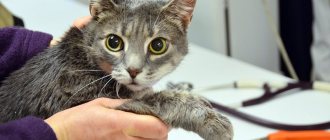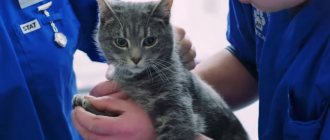A fairly common pathology in domestic cats, characterized by one or both testes not descending into the scrotum, is called cryptorchidism. A cryptorchid cat is not considered sick to the fullest extent of the word, but the phenomenon negatively affects the animal’s ability to produce offspring, and can also cause other ailments.
Today we will talk about how to identify cryptorchidism in a cat, whether castration of cryptorchid cats is mandatory, how the pathology is operated on, and we will discuss post-operative care for the animal.
Cryptorchid cat: surgery
Cryptorchidism in cats: general information
Most often, unilateral cryptorchidism occurs in cats - when one testicle is not descended into the scrotum. Among all animals suffering from this pathology, only two percent have bilateral cryptorchidism, that is, undescended two testes at once. Accordingly, bilateral cryptorzyme is an extremely rare phenomenon. Undescended testicles remain in the peritoneal cavity or “get stuck” in the inguinal canal.
Table 1. Variations in the occurrence of pathology - cryptorchidism
| Name | Description |
| Abdominal | The testis is located in the peritoneal cavity, inaccessible to palpation, and can only be detected through ultrasound examination. In this case, the testis in abdominal cryptorchidism is often underdeveloped, small in size, and may be hidden by intestinal loops or other organs. |
| Inguinal | An undescended testicle is located in the groin area, behind the fat layer, it is quite easy to feel, and in large adult cats with short hair, such an undescended testicle is visible to the naked eye - it looks like an oval tubercle above the scrotum. Cat owners are often frightened, mistaking this variant of cryptorchidism for a neoplasm. |
| False or pseudocryptorchidism | This variant of cryptorchidism, in fact, is not a pathology and has a second name - “wandering testis”. It is characterized by the retraction of a normally developed animal when the animal is afraid or the surrounding temperature is excessively low. |
| Secondary | A complication of false cryptorchidism, when initially both testes are developed normally and descended into the scrotum, but once the testicle is pulled inside, it no longer comes back - due to adhesions inside the peritoneal tissue or the fat layer in the groin area. |
False or wandering cryptorchidism
Complications from pathology
Cryptorchidism is dangerous, so it needs to be treated in a timely manner; the consequences of this pathology are:
- Cancer. The probability of its occurrence increases 10 times. This happens due to increased temperature in the abdominal space and the impossibility of spermatogenesis, as a result of which first physiological and then genetic changes in tissue occur. The highest probability of developing a tumor is with a unilateral intra-abdominal location of the testicle.
- Testicular torsion. Because of this, a sharp, severe pain occurs, which often does not stop and causes severe suffering to the animal for a long time. In this situation, internal bleeding may also occur if the spermatic artery is damaged.
- Infertility is observed in 80% of cases with bilateral cryptorchidism, but is not recorded with unilateral cryptorchidism.
- Hernias. They often occur from birth. In this case, hernias can, under certain conditions, threaten the life of the animal.
- Prostate dysfunction and its cancerous degeneration.
- With the hormonal nature of cryptorchidism, when the testes do not respond to gonadotropic hormone, a lack of testosterone occurs. A low amount of it leads to increased work of the anterior pituitary gland, which entails a systemic disruption of hormonal metabolism.
Causes of cryptorchidism in cats
This deviation does not have an exact and single cause, since the pathology usually has several provoking factors. First of all, these include deviations of a genetic nature, as well as features inherited from a mother or male cat: an excessively narrow inguinal canal, a predisposition to adhesions, a short testicular cord.
Also, a kitten can “get sick” with cryptorchidism due to an infection suffered by the pregnant mother or the kitten itself at an early age, as well as due to postnatal trauma. Pathology can also be caused by hormonal imbalances, as well as forced use of potent drugs by a pregnant cat or newborn kitten.
Unilateral cryptorchidism
Most cases of cryptorchidism in cats are associated with a lack of hormones. They are responsible for contracting a special ligament that pulls the testes from the peritoneal cavity into the scrotum. If there are not enough hormones, the movement of the testicles either does not begin at all or stops midway.
Another common cause of pathology is problems with the nervous and muscular apparatus of the groin area in general or the scrotum in particular. Such problems are considered to be a narrowed inguinal canal, folds blocking the “entrance” to the scrotum or an underdeveloped spermatic cord.
Undescended both testes
Strange as it may seem, the factor that provokes cryptorchidism in cats can be the negligence of the animal owner. Wanting to get offspring from a cat, the owner breeds it without passing the simplest tests on the pet, or without requiring such actions from the cat’s owner. As a result, the animals can infect each other with chlamydia, a virus or infection that will then affect the development of the kittens.
And finally, one of the rare provoking factors is overdeveloped and large testes that physically cannot enter the scrotum area; even the groin canals are of normal size.
Testicles that are too large may simply not fit into the scrotum
Features of cryptorchid sterilization
The cost of castration will be several times higher. This is not a whim of greedy veterinarians. Considering that the “lost” testes are (most likely) in the abdomen, abdominal surgery is required. It involves the mandatory administration of general anesthesia (which in itself is not cheap), the procedure takes many times longer.
Please note that preparation for surgery requires keeping your pet hungry for 12 hours. Another 3 hours before the procedure, the animal should not even be given water.
But sometimes you can get by with a little bloodshed. So, in some cases, the testicles are located close to the exit to the scrotum and can descend there when the cat is under severe stress, or when it is completely relaxed. In such situations, massage of the genital area helps: the testis comes out, it is “caught” and fixed using a loose ligature or elastic band placed on the scrotal sac of the scrotum.
But the main feature of castration of cats is the need for a preliminary medical examination. Using radiography and ultrasound, it is necessary to find out exactly where the organ is located. There are cases when the testicles only slightly did not reach the entrance to the scrotum, being located directly at the inguinal ring. But sometimes they are located deep in the abdominal cavity. Data obtained from research is used to plan surgery.
Cryptorchidism: clinical picture of pathology
The main symptom is, of course, a visual or manual defect. Cryptorchidism can be noticeable with the naked eye, as well as upon palpation. However, not every animal will allow you to palpate the intimate area, and not every owner is interested in probing the cat’s scrotum. In this case, nonspecific, non-characteristic signs become:
- Lack of pregnancy in a cat, despite multiple matings (the symptom may not appear in half of the cryptorchid cats - they continue to be able to “make” offspring).
- Cryptorchid cats, unlike full-fledged cats, are more likely to try to harass cats, even when they are not in heat. In turn, during a period favorable for mating, cats are more aggressive towards cryptorchids than towards cats with normal development.
- The scrotum does not look tight and full, but rather flabby and wrinkled.
- When urinating, the animal may shudder; cryptorchid cats often go “small” to the toilet, like dogs - with one hind paw raised.
Cryptorchid cats have peculiarities when urinating
- Concomitant diseases of the genitourinary system. Sometimes undescended testes are accompanied by testicular neoplasms.
- Loss of fur. Due to a lack of appropriate hormones, cryptorchid cats may begin to go bald. Darkening of the skin in the genital area is also observed - for the same reason.
- Tendency to lose masculinity. Cryptorchids, as they grow older, lose their brutal “masculine” features and become more refined, the skeleton becomes thinner, and the appearance of the cat becomes similar to the appearance of a graceful cat.
Cryptorchidism makes a cat look like a cat
But a rare symptom in cryptorchids is pain. Pathology produces painful symptoms only when the testes remaining in the peritoneal cavity already experience negative changes, for example, they become inflamed or develop into a neoplasm.
In severe cryptorchidism, the cat exhibits a painful reaction when the owner or veterinarian palpates the peritoneum. This is due to the twisting of the testicle on the axis, which entails pinching of the nerve canals, vessels and ducts that remove the seed. This process causes severe inflammation; in extreme cases, necrotic phenomena and even organ decomposition are possible.
The cat’s increased attention to the scrotum area is a reason to check the “set” of testes
How to care for an operated animal
If after regular castration caring for a pet is relatively simple, then in this case much more is required from the owner of the animal. Thus, it is necessary to ensure complete cleanliness of the postoperative wound, for which the pet should not be allowed outside. At least once every three days it is necessary to bring the cat to change the bandages.
The animal should be kept in a separate room with a minimum of furniture. Chests of drawers, chairs, bedside tables, etc. must be removed from there. This is due to the fact that the cat may try to jump on them, and this can lead to the seams coming apart.
The condition of the seams should be monitored daily. If redness, foul odor and/or pus appear, call your veterinarian immediately. You should not take your pet to the clinic, as in this condition the trip could end badly for him.
After castration, the animal is fed only high-quality, easily digestible food.
On the first day, it is advisable to limit your pet to only light chicken broths, which can be flavored with a small amount (very small) of finely chopped low-fat offal. It is allowed to include a small amount of boiled vegetables put through a blender into the post-operative diet. They contain fiber that stimulates peristalsis. This is a good prevention of constipation, which is often found in pets who have undergone abdominal surgery.
Castration of a cryptorchid cat has fundamental differences, which occur due to the fact that the testes are not in the testicles, but in another place, sometimes even in the abdominal cavity. The increasing complexity of the operation leaves its mark on the preparation for surgery and its consequences.
How to detect cryptorchidism in kittens and cats?
When purchasing a small kitten, the future owner is unlikely to be able to detect cryptorchidism in it. Firstly, the testes are still too small, and secondly, normally they can enter the scrotum for up to three to five months. If your pet has reached the age of six months, and one or two testicles are still not palpable, you need to visit a veterinarian.
Surgery is mandatory for a cryptorchid cat
Important point! Unscrupulous breeders can hide from the owner the fact that the kitten has a pathology. At the same time, if cryptorchidism is discovered in a cat, not only the owners who purchased a purebred animal with the initial prospect of breeding will suffer, but also the owners of the outbred cat, since both will need surgery.
If the testis, which has not descended into the scrotum, is not accessible for palpation, an ultrasound examination should be performed in order to draw up a surgical plan.
How to prepare a cat for an ultrasound?
Is it dangerous
Is cryptorchidism dangerous? Usually, owners do not notice any deviations in the behavior and condition of the animal. The absence of one or two gonads in the scrotum does not in any way affect the well-being of the pet. For this reason, contacting a veterinarian is often postponed.
However, cryptorchidism can have quite serious consequences. It is in the scrotum that the most favorable conditions are created for the normal functioning of the testicles. If the seminal glands are located in the groin or abdominal cavity, then they are constantly exposed to overheating. Over time, this can provoke malignant tumors of the testes. It is for this reason that veterinarians recommend castration of cryptorchid.
Testicular tumors are most often seen in dogs with cryptorchidism. However, such a complication cannot be ruled out in cats and stallions. In any case, the presence of the testes in the groin or abdomen has a detrimental effect on the condition of the tissues of the gonads.
In addition, cryptorchidism can cause testicular torsion and prostate tumors. We can conclude that such an anomaly is far from harmless.
Treatment for a cryptorchid cat
Cryptorchidism itself is not a fatal disease, and in some cases it is not dangerous to the health of the cat. But this does not mean that the owner should ignore the problem. There are two options for treating a cryptorchid cat: with drug therapy and surgery.
Cryptorchidism and hormone therapy
To treat cryptorchidism, in some cases, hormonal drugs are used, which are designed to compensate for the lack of the cat’s own hormones. This treatment option is used only after completing a full course of tests and studies, and with a confirmed lack of the hormone testosterone. That is, in the case when its deficiency is really the root cause of the pathology.
The use of hormone therapy in kittens under one year of age is prohibited, since drugs that include a serious dose of testosterone negatively affect the hypothalamus, which will certainly affect the proper growth of bones and ligaments in the skeleton of a young animal.
Hormone therapy is only permissible for mature adult cats.
Note that drug treatment is often ineffective at all, or has a temporary positive effect. As soon as artificial testosterone is no longer administered to the animal, the pathology reasserts itself.
In addition, hormone therapy requires expensive tests, and the price of the drugs themselves is quite high. Veterinarians argue that there is no particular point in trying to treat a cat in this way - anyway, the animal should not be allowed to be bred so that it does not pass on the inferiority gene to its offspring.
Even cats with cured cryptorchidism are not allowed for breeding
Cryptorchid sterilization
According to veterinary experts, the most effective and radical way to solve a problem such as cryptorchidism is to sterilize the animal. We are talking specifically about sterilization, not castration, since cryptorchids require a full-fledged strip operation.
The intervention of a veterinary surgeon will not only ensure complete suppression of the animal’s desire to continue its breeding, but will also not allow the undescended testis to degenerate into a malignant tumor. It is this “side effect” that is the most terrible for a cryptorchid cat.
The process of sterilization of a cat with cryptorchidism
The ideal age to perform surgery on a cat is seven to eight months, but later surgical intervention is possible, up to eight to nine years. Before performing abdominal surgery, you need to consult with a specialist, take biochemistry and a general blood test with the animal, and also perform an ECG procedure in order to rule out cardiac ailments of the cat that could negatively manifest themselves during the administration of anesthesia or the operation itself.
As we have already mentioned, sterilization of a cat with pathology is a full-fledged operation, during which the surgeon enters the abdominal cavity of the animal. The operation takes place under full anesthesia and lasts approximately one and a half hours. Operative access will depend on which variation cryptorchidism belongs to.
Before surgery on an animal, you need to undergo a short medical examination.
Surgery for inguinal cryptorchidism
The animal, which has passed the tests, is put under anesthesia. The doctor will then use an electric razor to shave the hair around the incision area. The skin and adipose tissue are cut with a scalpel, the undescended testis is removed, and the testicular cord is cauterized with an electrical device - a coagulator. Stitches are then applied.
To protect the operated area from the cat’s rough tongue (during healing, the stitches itch and the cat will try to lick them), you need to put a special plastic collar on the cat. The pet will wear this collar until the suture material is removed - usually this happens within ten days after the operation.
The cat must be wearing a protective collar at all times.
It is also prohibited for a cat to lick a seam because a pet can easily introduce bacteria and dirt into a fresh wound along with saliva. Sutures need to be treated daily; Chlorhexidine is good for this purpose, but the doctor can independently smear the incision site with a long-acting antiseptic.
Surgery for abdominal cryptorchidism
This operation almost completely copies sterilization in cats. The animal is put under anesthesia, the belly is shaved, and then the belly is incised along the “linea alba,” finding the vas deferens. It is located next to the bladder, and the incision will be in this area. One or two testicles remaining in the peritoneum are pulled out and removed, after which suture material is applied.
Cat in anesthesia
Just like after surgery for inguinal cryptorchidism, the cat will need to purchase a protective collar, which he will wear until the stitches are removed.
Video - Operation for a cryptorchid cat
Gentle castration of cats in Rostov-on-Don.
If you have a young or not so young cat, he has started to mark, or you have thought ahead and want to avoid all these troubles, as well as maintain his health and your peace of mind - contact us, we can help. If you have any doubts or questions, we will advise you, our doctors know everything about castration of cats and work using modern gentle methods, when there is no need for stitches or dressings, any cat returns to its normal rhythm of life on the same day.
Advantages of the gentle method compared to the classic one:
- High-quality analgesia is used with foreign drugs that are specially designed for general anesthesia and pain relief, directly for cats, so the body perceives them better than analogues from medical practice.
- Through a small access, the surgeon carefully and completely removes the testes and their appendages (this will help stop the marks and screams), and the scrotum itself remains and is not removed, and after a while it will be practically not noticeable from the cat that he has been castrated.
- The cat will not need bandages, collars or dressings. This is good for its convenience and will save your time. There will be no stitches either, which will help avoid repeated visits to the clinic to have them removed.
- The first time after the castration procedure, a long-acting painkiller will act, so the cat will not experience any discomfort at all.
- Anti-inflammatory drugs, as well as painkillers, will have a long-lasting effect, so during the recovery period it will be possible to do without medications, injections or any medical procedures.
The operations are performed by a doctor specializing in castration; before the procedure, the cats are fully examined for contraindications, and only after that we begin work. Our doctors have good experience and know everything about castration, so you can trust us!
Rehabilitation after surgery
When taking an animal home after surgery, the owner should be aware of some rules that will allow rehabilitation to be carried out quickly and with minimal discomfort for the cat.
Firstly, you need to prepare in advance the place where the cat will be for the first hours after the operation. The animal is protected from drafts and excessively hot radiators. Fine. If you manage to restrict your pet’s movements using a carrier or cage, the cat will feel insecure when recovering from anesthesia and may get injured.
During the first hours after recovery from anesthesia, the cat should be monitored or placed in a cage.
You need to carefully monitor your pet's condition, reporting any negative changes to your doctor. If the cat refuses to eat for the first day or two, it's not a big deal. If the animal continues to ignore food, behaves lethargically and is not interested in anything, this is a reason to urgently visit a doctor.
Another common side effect of abdominal surgery in cats is the absence of bowel movements. To help your pet, you can give him a teaspoon of Vaseline oil, which acts as a mild laxative. But, it is worth using it on the third or fourth day if the cat was still unable to defecate on its own.
The oil can be mixed with food or administered into the cat's mouth using a rubber bulb.
You must also carefully follow the individual recommendations of your veterinarian. The cat may be prescribed hemostatic drugs, anti-inflammatory or antibiotics, and vitamins.
Castration of cats - dispelling myths.
Neutering a male cat causes him to “lose his personality” - After neutering, male cats no longer feel like they have to fight for their territory. Without the stress of fighting, owners often find that their cats are friendlier. Overall, there are no real changes in character due to the operation, although if there are any, they will only be positive.
Castration of cats causes them to gain weight. None of the castrated cats gained weight as a direct result of the operation. Due to the lack of territorial behavior, decreased anxiety levels can lead to a possible increase in appetite. As long as the cat eats a balanced diet, except for overfeeding, nothing can affect its weight gain. Most responsible owners will be aware of this and will take these features into account when feeding their neutered cats, especially since it is very easy to do.
The cat becomes depressed and anxious if he is unable to reproduce. Sex, for most animals, including cats, is only an instinctive tool of behavior that is driven by hormones. With the help of these hormones, it is possible to completely reduce and remove it after surgery, and the need for sexual activity will be eliminated. This way, stress and anxiety levels will actually be reduced since the cat won't have to search for cats.
Is it possible to determine the sex of newborn babies?
To start raising a kitten, it is very important to determine the gender as early as possible (preferably in infancy). This way you can apply the correct taming techniques to the tray, scratching post and bathing, as well as select the right food, vitamins and get the necessary vaccinations.
At first glance, it is almost impossible to understand for sure whether a newborn baby is a boy or a girl, due to the structural features of the body. Don’t despair and seek help from a veterinarian or a familiar felinologist!
As a rule, a cat's litter gives birth to babies of different sexes. This feature will help you almost unambiguously identify boys and girls among babies. To determine the sex, you just need to compare the kittens' genitals.
The baby’s body is still very weak, so you need to act with extreme caution:
- gently grab the kitten by the scruff of the neck (as a mother cat does) and place it, belly down, in your palm;
- then carefully raise the baby to eye level, so that you can easily inspect everything;
- slowly lift your ponytail;
- begin visual gender determination.
Photo: the example shows that the genitals of newborns are different, a boy on the left, a girl on the right
You should know that the genitals of newborn kittens are just beginning to form. Therefore, pay attention to the distance between the genitals and the anus: in girls it is much smaller than in boys.
When visually inspecting, be careful not to scare or harm the newborn kitten. If the baby begins to meow pitifully, his mother will become seriously worried: she will start calling her children, constantly dragging them to new shelters.
You can also observe the behavior of newborns. Usually girls are calmer, sleep a lot and eat more willingly. Boys squeak more often, looking for new adventures, climbing on their mother or crawling around the house.
Never “check” the floor too often or forcefully. Firstly, you will only become more confused in your conclusions, and secondly, such actions create a lot of stress for both the mother cat and her babies.
Try to consider the following tips:
- do not lift kittens by the tail;
- do not take babies away from their mother during feeding;
- do not try to feel something in the pet’s genital area - you can damage the fragile organism;
- It is better not to touch the kittens unnecessarily, as the alien smell can frighten the mother cat and force her to abandon the children.











